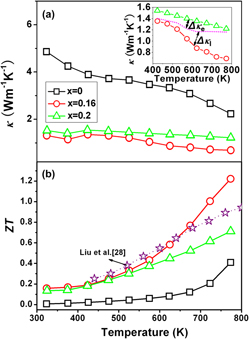Article contents
Enhancing thermoelectric properties of Cu1.8+xSe compounds
Published online by Cambridge University Press: 13 May 2014
Abstract

P-type Cu1.8+xSe (x = 0, 0.16, 0.20) compounds were synthesized by mechanical alloying and spark plasma sintering technique. A 100% enhancement of the Seebeck coefficient was achieved in the whole temperature interval for x = 0.16 and x = 0.20 bulks compared with that of the x = 0 bulk. The thermal conductivity was all below 1.6 W m−1 K−1 in the whole temperature interval for x = 0.16 and x = 0.20 bulks, showing a pronounced reduction compared with that of the x = 0 bulk. The lowest thermal conductivity 0.69 W m−1 K−1 was achieved in the x = 0.16 sample at 773 K, whereby a maximum ZT value of 1.23 was obtained, revealing that optimizing Cu content in Cu1.8+xSe system is an effective method to improve the thermoelectric (TE) merit and indicating a great potential for TE application along with their nontoxicity and low cost.
- Type
- Articles
- Information
- Copyright
- Copyright © Materials Research Society 2014
References
REFERENCES
- 8
- Cited by


